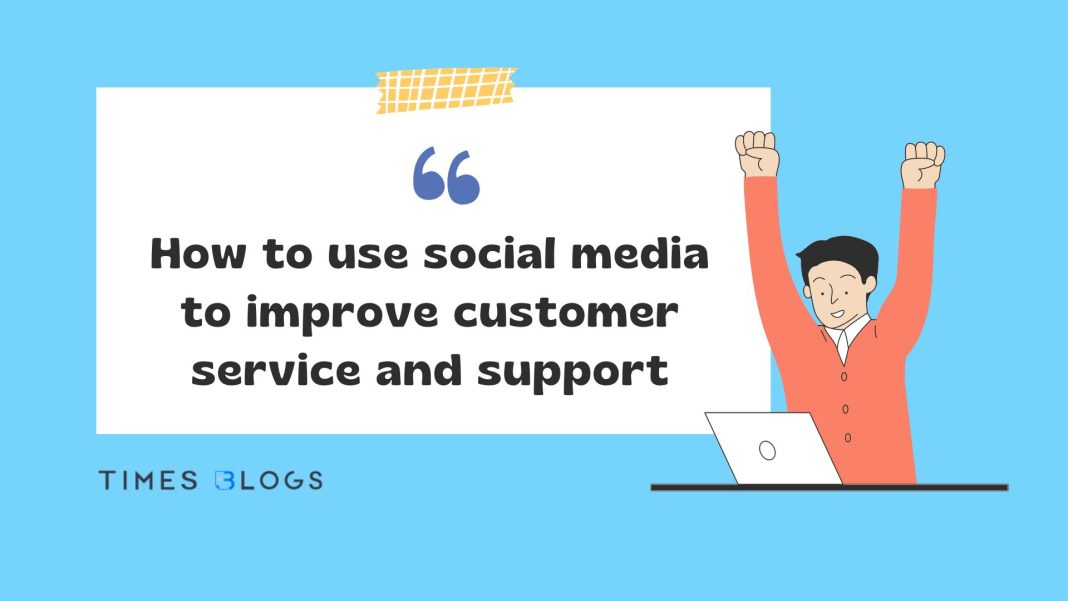In today’s interconnected world, using social media for business functions goes beyond marketing and brand building. It has become an essential channel for customer service and support. This post aims to explore how you can use social media to improve customer service, fostering relationships that will keep your customers coming back time and again.
Did you know that a whopping 67% of consumers have utilized a brand’s social media channel specifically for customer service? This is a compelling reason to use social media to improve customer service in your own business. By doing so, you not only meet your customers where they are but also turn potential grievances into opportunities for building brand loyalty.
Whether you’re a small business owner, a customer service representative, or a social media manager, this comprehensive guide is tailored for you. We’ll delve into strategies, best practices, and tools that will help you elevate your customer service capabilities on social media platforms. So, buckle up and let’s embark on this journey to significantly enhance your customer service metrics through social media.
Table of Contents
The Importance of Customer Service in Social Media
The Importance of Social Media to Improve Customer Service
In today’s interconnected marketplace, customer service plays a crucial role in shaping brand loyalty and reputation. A significant 67% of consumers have turned to a brand’s social media specifically for customer service needs, as highlighted by a JD Power and Associates Report. This statistic is more than just a number; it’s a loud wake-up call emphasizing why businesses must use social media to improve customer service.
Why is it Important?
- Real-Time Engagement:
Social media platforms offer a unique benefit—immediacy. Unlike traditional customer service avenues, social media allows for rapid-fire interactions. Consumers can tweet a question or post a complaint and expect a swift response. This real-time nature of social media helps elevate customer service from a mere post-purchase formality to a central factor in customer satisfaction. - Increased Visibility:
Beyond immediacy, social media platforms are public forums where brand interactions are visible to a larger audience. When you resolve customer issues or answer questions effectively on social media, you don’t just win back a customer; you publicly demonstrate your brand’s commitment to customer satisfaction. - Customer Retention:
Effective use of social media in customer service can significantly improve customer retention rates. When a brand consistently demonstrates its willingness to resolve issues and engage with its audience, customers are more likely to remain loyal, showcasing why it’s beneficial to use social media to improve customer service. - Sales Opportunities:
Exceptional customer service on social media can also open up new avenues for sales. Satisfied customers are often more open to additional offers, cross-selling, and upselling, further amplifying why it’s crucial to integrate social media into your customer service strategy.
By integrating social media into your customer service strategy, you’re not only meeting the consumer where they’re most active but also turning potential grievances into opportunities for enhancing brand loyalty and even generating new sales. Simply put, it’s no longer optional for brands aiming for long-term success; it’s essential to use social media to improve customer service, customer retention, and overall brand health.
So there it is—clear, compelling reasons laying out the urgency and benefits of incorporating social media into your customer service strategy. Businesses aiming for long-term success can’t afford to overlook this critical channel. Ignoring the importance of using social media for customer service would be a missed opportunity for enhancing customer satisfaction and brand reputation.

Why Use Social Media for Customer Support?
The digital age has redefined the way businesses interact with their customers, ushering in new paradigms that place the consumer at the center of brand experiences. So, why exactly should a brand use social media to improve customer service? Let’s delve into some compelling reasons:
1. Instant Feedback
The first and most evident advantage is the immediacy of feedback. Traditional customer service channels may require customers to go through multiple steps or wait in long queues to get their issues addressed. Social media changes that narrative. With platforms like Twitter and Facebook, a customer can post a query or a complaint and receive a near-instantaneous response. This immediacy can make customers feel valued and heard, providing a strong incentive to use social media to improve customer service.
2. Public Interactions
In the world of customer service, reputation is everything. One of the beauties of using social media for customer support is the public nature of interactions. When a brand efficiently handles a complaint or question in the public eye, it not only resolves that specific issue but also demonstrates to other customers and potential customers that the company values consumer satisfaction. A well-handled public interaction can turn even a dissatisfied customer into a loyal advocate, proving once again the necessity to use social media to improve customer service.
3. Multi-Channel Support
Customers today are everywhere—scrolling through Instagram feeds, networking on LinkedIn, tweeting, or even shopping directly through Facebook. Each platform serves as a potential touchpoint for customer service. By utilizing these various channels, brands can offer multi-channel support that meets customers where they already spend their time. This omni-channel approach can unify the brand’s message and service, making it indispensable for companies to use social media to improve customer service.
4. Proactive Customer Service
By keeping an eye on social media mentions and hashtags related to your brand, you can engage in proactive customer service. Addressing issues before they escalate into bigger problems not only prevents potential crises but also portrays your brand as attentive and responsive. This proactive approach can set you apart from competitors who may only engage in reactive customer service.
5. Data-Driven Insights
Social media platforms offer a wealth of data that can be leveraged to improve customer service. By analyzing customer interactions, complaints, and feedback, brands can gain valuable insights into what customers really want and expect. This data-driven strategy can guide service improvements, product enhancements, and even inform future marketing campaigns.
The benefits of using social media for customer support go beyond the obvious advantages of instant feedback and public interactions. The multi-channel nature of social media offers a holistic approach to customer service, while the potential for proactive engagements and data-driven insights provides additional layers of value. In today’s competitive landscape, it’s not just a recommendation but a requirement to use social media to improve customer service. Ignoring this dynamic channel could mean missed opportunities and a dent in your brand reputation.
Check our social-media-related articles:
- How AI Chatbots are Transforming Customer Service
- How to Use Social Media to Increase Website Traffic and Conversions
- How to create a successful social media marketing campaign
- How to grow your social media following
- The Psychology Behind Social Media Addiction, Struggles, and How to Break Free from It
Types of Customer Service via Social Media
In the quest to use social media to improve customer service, it’s important to understand that not all social customer service strategies are created equal. Depending on your brand’s objectives, resources, and customer needs, you may choose to implement one or a combination of different types of customer service on social media. Let’s break down the primary types:
1. Reactive Customer Service
The most basic form of customer service on social media is reactive. In this approach, the brand waits for customers to reach out with their queries, complaints, or mentions. Once received, the customer service team responds directly to address the issue. While this method is the most straightforward, it’s also essential. Customers expect timely and effective responses when they reach out directly, and well-managed reactive customer service can significantly improve customer satisfaction.
2. Proactive Customer Service
Being proactive takes customer service a step further. Here, the brand doesn’t just wait for direct mentions or queries; it actively scans social media platforms for indirect mentions, discussions, or even general customer sentiments related to their products or services. By jumping into these conversations with helpful information, clarification, or solutions, a brand can not only solve issues before they become major problems but also positively surprise customers, making them feel valued and heard.
3. Social Listening
Social listening goes beyond even proactive customer service by employing specialized tools to monitor social media for mentions, keywords, or trends that relate to the brand. This approach allows companies to capture the broader landscape of customer sentiment, including both the good and the bad. By quickly acting on these insights, a brand can celebrate positive mentions and mitigate negative ones, further cementing its reputation as a customer-centric organization.
In the digital age, the push to use social media to improve customer service has become more critical than ever. Whether you opt for a reactive, proactive, or social listening approach—each has its merits and potential drawbacks. What’s key is understanding the specific needs and expectations of your customer base, and then tailoring your social media customer service strategy accordingly. By leveraging these diverse types of customer service via social media, brands can create a more holistic, responsive, and customer-focused experience, fortifying both their reputation and their bottom line.

Setting Up Social Media Channels for Customer Service
In today’s competitive landscape, mastering how to use social media to improve customer service is paramount. But hopping onto a social media platform and answering queries isn’t enough. Crafting an effective social media customer service strategy requires planning, execution, and ongoing adaptation. Here’s a step-by-step guide to successfully setting up your social media channels for enhanced customer service:
1. Choose the Right Platforms to Engage Your Customers
To use social media to improve customer service, first, identify where your target customers spend their digital lives. Various social media platforms attract different demographics and offer unique features. Conduct market research to pinpoint the right platforms that align with your audience. This strategic choice will enable you to effectively use social media to improve customer service by reaching a larger and more relevant user base.
2. Set Up Dedicated Support Handles for Improved Customer Service
To streamline your customer service activities, consider establishing dedicated support handles, especially on platforms like Twitter. Handles such as “@CompanyNameSupport” can channel customer service queries away from your main brand presence, making it easier to manage and focus on customer support. This is another key component in using social media to improve customer service, as it offers a separate but linked space solely for customer queries and complaints.
3. Develop a Robust Response Plan
With the platforms selected and handles in place, the next key step in using social media to improve customer service is to develop a comprehensive response plan. Draft templates and standard operating procedures for frequently asked questions or common complaints. These resources can speed up your response time and ensure uniformity in your customer interactions.
4. Train Your Customer Service Team
A well-trained team is crucial when aiming to use social media to improve customer service. Equip your customer service representatives with the skills to navigate the chosen platforms and familiarize them with your response plan. Their competence will directly reflect on your brand’s reputation online.
5. Implement Monitoring Tools for Real-time Customer Engagement
To excel in using social media for customer service, employ social listening and monitoring tools. These tools scan for brand mentions, hashtags, and direct queries, enabling you to promptly address customer concerns and feedback.
6. Continually Measure and Adapt for Optimal Results to Use Social Media to Improve Customer Service Effectively
The final and ongoing phase to successfully use social media to improve customer service involves tracking key performance indicators like response time, customer satisfaction scores, and resolution rates. Continuously monitor these metrics to refine your strategy and further improve your customer service on social media.
Using social media to improve customer service is more than just being active on various platforms. It involves strategic planning from choosing the right platforms and setting up dedicated customer service handles to implementing a thorough response plan and rigorous training. Continuously measure your performance to adapt and refine your strategy. By doing so, you not only meet but also exceed customer expectations, solidifying your brand’s reputation and encouraging customer loyalty.
Essential Social Media Customer Service Tools
To effectively use social media to improve customer service, you’ll need more than just well-trained staff and a solid strategy; you’ll also need the right tools. The following is a roundup of some essential tools that can supercharge your social media customer service efforts:
1. Chatbots
Chatbots are AI-driven tools that can engage customers in real-time conversations and handle basic queries instantly. Whether it’s providing information about products, guiding users through a process, or answering frequently asked questions, chatbots can alleviate the pressure on human agents and offer quick responses to customers.
2. CRM Systems
Customer Relationship Management (CRM) software allows you to store and manage customer information in one centralized location. When integrated with your social media platforms, CRM systems can offer insights into customer history, preferences, and past interactions, enabling you to provide a more personalized and informed service.
3. Analytics Tools
You can’t improve what you can’t measure. Analytics tools help you to track a variety of Key Performance Indicators (KPIs) such as response time, customer satisfaction scores, and the number of resolved issues. By regularly analyzing this data, you can make informed decisions to enhance your social media customer service strategy.
4. Social Media Management Platforms
Tools like Hootsuite, Sprinklr, or Buffer allow you to manage multiple social media accounts from a single dashboard. These platforms often come with built-in analytics, scheduling, and monitoring capabilities, making it easier to manage customer interactions across different channels.
5. Knowledge Bases
Integrating a knowledge base with your social media channels can provide customers with quick access to FAQs, guides, and how-to articles. This self-service approach empowers customers to find solutions to common problems without having to reach out to a human agent.
6. Sentiment Analysis Tools
Understanding the sentiment behind customer interactions can offer valuable insights. Sentiment analysis tools scan customer comments and queries to gauge the mood of the customer. This information can help agents tailor their responses more effectively.
The landscape of social media customer service is constantly evolving, and staying ahead of the curve requires not just a robust strategy, but also the right set of tools. From chatbots that offer immediate responses, to CRM systems that personalize customer interactions, and analytics tools that measure your effectiveness, the right toolkit can significantly improve your ability to use social media for customer service. Combining these tools with a well-crafted strategy can turn your social media channels into customer service powerhouses, enhancing both customer satisfaction and your brand’s reputation.
Social Media Etiquette in Customer Service
While tools and strategies are crucial for the execution of effective customer service through social media, the manner in which you communicate is equally important. The digital age demands not just quick solutions but also respectful and empathetic interactions. Following social media etiquette can significantly boost your efforts to use social media to improve customer service. Here are some key aspects to consider:
1. Timeliness
Customers have come to expect quick responses when they engage with a brand on social media. Delays can lead to frustration and possibly even public complaints that can harm your brand’s reputation. Aim to respond to queries and complaints as swiftly as possible, ideally within an hour or two.
2. Transparency
There will be instances when you cannot resolve an issue immediately. In such cases, it’s crucial to be upfront and honest with the customer. Explain the situation, give them a timeframe for resolution, and keep them updated on progress. Transparency builds trust, even when you’re dealing with problems.
3. Tone and Language
The language you use when interacting with customers should be in line with your brand’s voice but also adapted to the nature of the conversation. While some brands can pull off a casual or even humorous tone, customer service interactions should always maintain a certain level of professionalism. Courtesy is non-negotiable.
4. Follow-Up
Resolving an issue shouldn’t be the end of your interaction with a customer. Always follow up to ensure that the customer is satisfied with the solution provided. This not only shows that you care but also gives you an opportunity to turn a one-time service interaction into an ongoing relationship.
5. Personalization
While canned responses can help in handling high volumes of similar queries, personalization goes a long way in making the customer feel valued. Use the customer’s name and refer to any past interactions if applicable for a more personalized touch.
6. Public vs Private Conversations
While it’s essential to acknowledge a complaint or query publicly for the sake of transparency, sensitive issues should be taken to private messages (PMs) or Direct Messages (DMs) as soon as possible. This protects the privacy of the customer while also taking the conversation away from the public eye.
Etiquette may seem like an old-fashioned concept, but its importance in digital customer service interactions cannot be overstated. Proper etiquette ensures a respectful, transparent, and efficient communication process that complements your efforts to use social media to improve customer service. By adhering to these etiquette guidelines, you not only meet the immediate needs of your customers but also contribute to long-term relationship building and brand loyalty.

Tracking Your Success in Social Media Customer Service
After you’ve set up your social media customer service channels, developed a strategy, and trained your team, it’s essential to track the effectiveness of your efforts. How do you know if you’re actually using social media to improve customer service? Metrics and KPIs (Key Performance Indicators) provide the answer. Here are some vital metrics to track:
1. Customer Satisfaction Scores (CSAT)
The Customer Satisfaction Score (CSAT) is a straightforward metric that measures customer satisfaction at the interaction level. After resolving a customer query or problem, ask them to rate their satisfaction on a scale, usually ranging from very dissatisfied to very satisfied. This provides instant feedback on how well your team is performing.
2. Net Promoter Score (NPS)
The Net Promoter Score (NPS) goes beyond individual interactions to measure overall customer loyalty. Customers are asked how likely they are to recommend your brand to others on a scale of 0 to 10. Those who score 9-10 are considered promoters, while those who score 0-6 are detractors. Subtracting the percentage of detractors from the percentage of promoters gives you the NPS.
3. Response and Resolution Time
Time is of the essence in customer service, especially on platforms where interactions are public. Monitor how long it takes for your team to respond to initial queries as well as how long it takes to resolve issues completely. Quicker times are generally better but must be balanced against the quality of service.
4. Social Media Engagement
While not a customer service metric per se, the level of engagement your customer service posts receive can be a good indicator of how well you’re doing. Positive reactions, shares, and even comments can mean that you’re handling issues in a way that resonates with your audience.
5. Escalation Rate
Keep track of how many issues have to be escalated to higher levels of support or other platforms. A high escalation rate could indicate that your social media customer service team is not adequately equipped to handle the issues they are facing, suggesting the need for additional training or resources.
6. Return on Investment (ROI)
Finally, calculating the ROI of your social media customer service can give you a holistic view of its effectiveness. Compare the costs of operating your social media customer service against the value it brings in terms of customer retention, upsells, and even new customer acquisition through positive reviews and word-of-mouth.
Tracking your success isn’t just a one-time activity; it’s an ongoing process. By consistently monitoring these KPIs, you get valuable insights into how effectively you’re using social media to improve customer service. These metrics allow you to identify areas for improvement, make data-backed decisions, and ultimately, provide a better customer service experience.
Case Studies: How Brands Excel in Social Media Customer Service
Understanding how to use social media to improve customer service becomes easier when you can observe real-world examples. Below are case studies of two companies that have effectively leveraged social media platforms to elevate their customer service experiences.
Case Study 1: JetBlue Airways
JetBlue Airways is often cited as a company that has successfully integrated social media into its customer service strategy. The airline’s Twitter account is particularly active, with customer service agents providing real-time updates on flight delays, cancellations, and answering passenger queries.
Key Takeaways:
- Proactive Communication: JetBlue doesn’t wait for a crisis to hit before they communicate. They proactively share updates, often before customers even ask.
- Personalized Service: Responses from JetBlue’s Twitter account are not generic; they engage with customers on a personal level.
- Speedy Responses: The airline is known for its swift replies, enhancing customer satisfaction and loyalty.
Case Study 2: Zappos
Zappos, the online shoe and clothing retailer, is renowned for its customer-centric approach, and this extends to its social media channels as well. They are known for going above and beyond the call of duty—sometimes sending flowers, cakes, or even having conversations that have nothing to do with shopping!
Key Takeaways:
- Unique Brand Voice: Zappos’ quirky and personalized style makes customers feel like they’re interacting with a human, not a corporation.
- Going the Extra Mile: Their customer service team has been known to assist customers in ways that are beyond the traditional scope of customer service, creating memorable experiences.
- Multi-Channel Support: Zappos leverages multiple social media channels to provide comprehensive customer service, ensuring they meet customers where they are most comfortable.
Case Study 3: Starbucks
Starbucks is a brand that has effectively used social media as a two-way communication channel with its customers. Their Twitter and Instagram accounts not only serve as platforms for advertising but also for listening to customer feedback and providing assistance.
Key Takeaways:
- User-Generated Content: Starbucks often shares customer-created content, which acts as social proof and fosters a sense of community.
- Real-Time Engagement: Whether it’s addressing complaints or simply sharing customer excitement over seasonal drinks, Starbucks is quick to engage.
- Innovative Solutions: From mobile orders through tweets to interactive campaigns, Starbucks uses technology creatively to solve customer queries and issues.
Case Study 4: Slack
Slack, the business communication platform, offers an excellent example of B2B social media customer service. They have a dedicated ‘@SlackHQ’ Twitter account where they address customer issues, release updates, and even share user tips.
Key Takeaways:
- Technical Expertise: Slack’s social media customer service is adept at handling complex queries, often directing users to the proper documentation or resources.
- Transparency: If the service faces downtime or issues, Slack is upfront about it on social media, often providing real-time updates on problem resolution.
- Educational Content: Besides offering customer service, Slack uses its platforms to educate users about features, integrations, and best practices.
Case Study 5: Tesla
Tesla, the electric vehicle and clean energy company, offers a unique approach to customer service via social media, especially through its CEO, Elon Musk. While it may not be a conventional strategy, Elon Musk’s Twitter interactions have served as an unconventional customer service channel for Tesla.
Key Takeaways:
- C-Suite Engagement: Having the CEO directly interact with customers is rare but impactful. It sends the message that even the highest levels of the company are engaged in customer service.
- Immediate Action: Elon Musk has been known to implement changes to Tesla products based on customer feedback received via Twitter, showing the company’s commitment to continual improvement.
- Public Relations: While not every interaction is purely about customer service, the company’s social media strategy also serves as an effective PR channel, making customers feel like they’re part of something bigger than just a purchase.
Case Study 6: Warby Parker
Warby Parker has redefined eyewear retail not just with its innovative business model, but also with its exceptional customer service, particularly on social media platforms. They’ve made eyewear fashionable, affordable, and socially conscious, and their customer service reflects these brand values.
Key Takeaways:
- Personalized Video Responses: Warby Parker takes personalization to a new level by sometimes sending video responses to customer queries, making the interaction much more engaging.
- Style Advice: They offer style advice directly through social media channels, helping customers make choices and providing a shopping experience akin to an in-store visit.
- Responsiveness: Warby Parker is known for quick and thorough responses, even going as far as to check back with customers to confirm that their issues were resolved satisfactorily.
From traditional industries like airlines (JetBlue) and retail (Zappos) to modern tech platforms (Slack) and innovative disruptors (Tesla, Warby Parker), these case studies demonstrate the extensive ways businesses can use social media to improve customer service. Each case study offers unique takeaways, whether it’s proactive communication, personalization, technical expertise, C-suite engagement, or style advising. What ties them all together is their ability to elevate the customer experience through thoughtful, effective social media interactions. These real-world examples provide a valuable roadmap for any business looking to enhance their customer service using social media channels.
Final Thoughts
In this rapidly evolving digital landscape, the imperative to use social media to improve customer service has never been more clear. Gone are the days when customer service was a mere afterthought or a necessary evil. Today, it’s a vital brand differentiator that has a direct impact on a business’s bottom line. From immediate feedback and multi-channel support to social listening and proactive engagement, social media offers myriad opportunities to take your customer service to the next level.
The case studies of JetBlue, Zappos, Starbucks, Slack, Tesla, and Warby Parker offer invaluable lessons in how diverse industries are harnessing the power of social media to enhance their customer service. Whether it’s quick response times, personalization, or direct engagement from senior leadership, these brands show that effective customer service on social media can come in various forms but always results in satisfied, loyal customers.
With the right mix of strategy, tools, and a relentless focus on the customer, your business can not only resolve issues efficiently but also turn customers into brand advocates. So take the plunge, incorporate social media into your customer service strategy, and prepare to reap the rewards in customer satisfaction, loyalty, and ultimately, business success.




